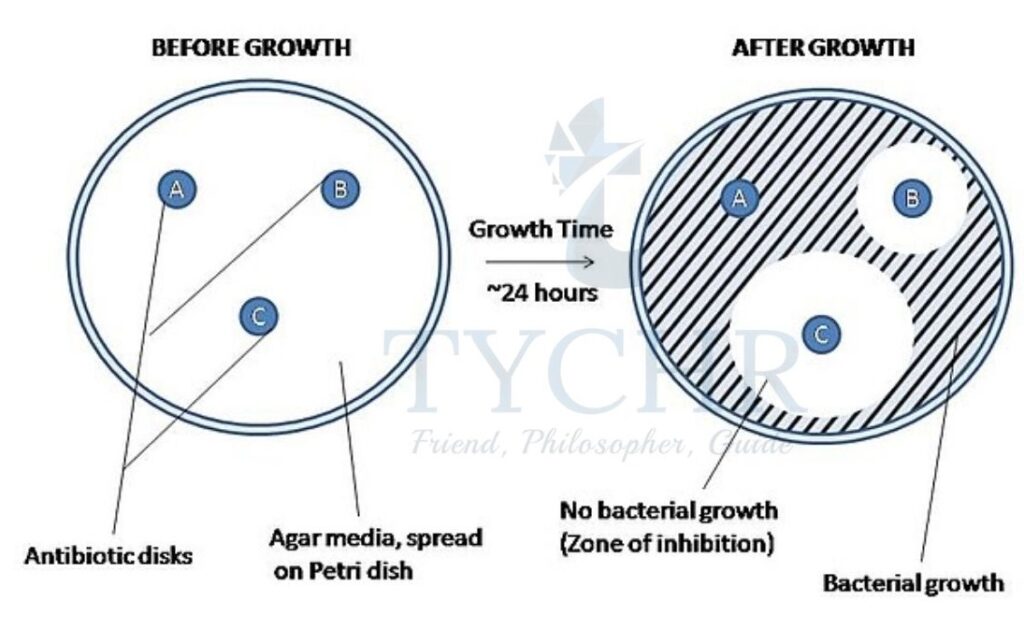Evolution And Biodiversity Notes
Evolution and biodiversity
Approaching the topic:
- Understanding the topics
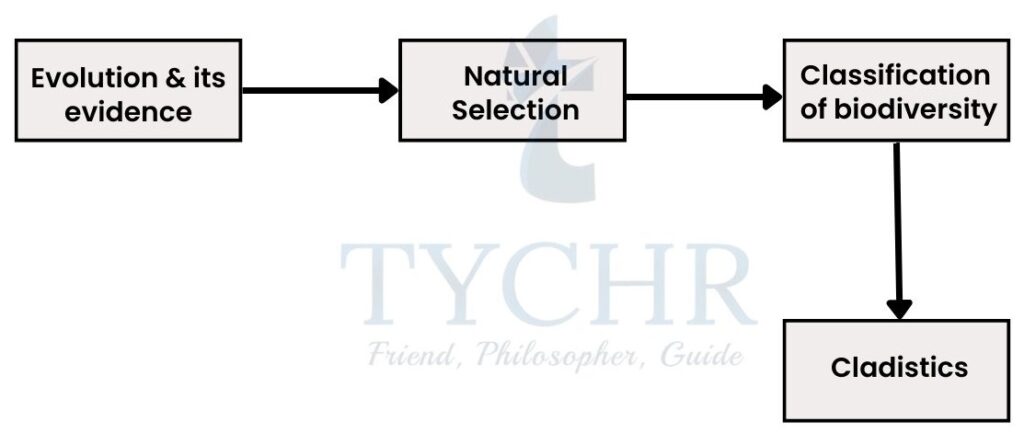
- Application of these concepts
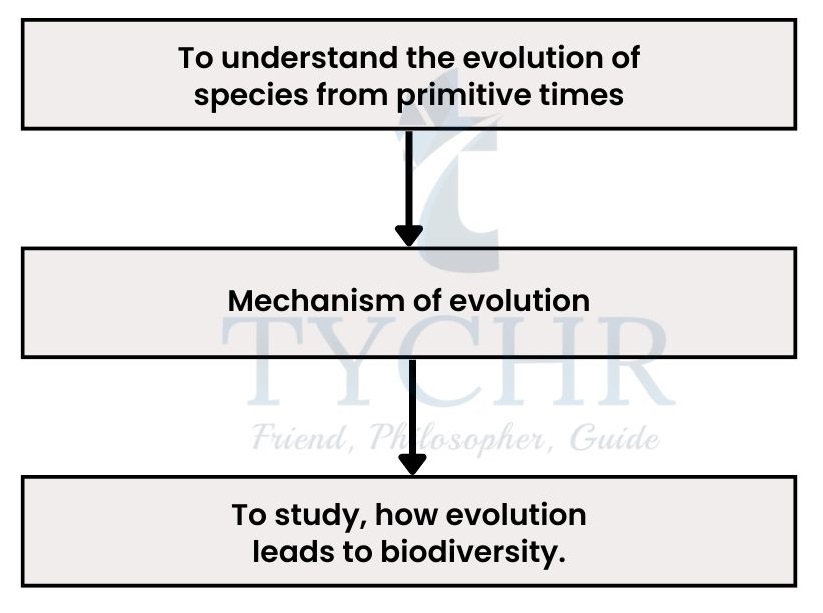
Basic terms to ponder:
- Speciation: A process by which one or more species arise from previously existing species.
- Variation: It is the differences between species due to genetics.
- Holotype: It is a single specimen which needs to be represented while naming a newly found species.
- Cladogram: It is the representation of cladistics study.
Evolution and its evidences
Evolution
- It is defined as the cumulative or sudden change in the heritable characteristic of a population
-
This change in a population leads to speciation and the two populations can no longer interbreed.
Evidences for evolution
- There are three primary pieces of evidence for evolution by natural selection which are fossil records, animal breeding and homologous & analogous structures.
- Fossil record
- Fossils are the petrified remains or traces of animals and plants and the accumulated evidence from these remains are called fossil record.
- Fossils can be as old as thousands of millions of years, which gives us clues that life forms existed millions of years ago and gives us evidence that life on earth is changing constantly with time.
- How is the age of the fossils determined?
- Fossils are petrified on rocks and it contains isotopes. Examining the ratio of these isotopes remaining in the rock can tell the age of the rock and that of fossils. There are two techniques which are used to determine the age of the fossils using isotopes:
-
- Carbon dating
C-14 is an isotope of C-12, and is radioactive i.e. it gradually decays and gives off its radioactivity and changes into another stable elemental form, nitrogen-14.
C-14 has half-life of 5730 years i.e. the petrified fossil will lose half of its C-14 after 5730 years and half of that in another 5730 years. - Potassium-argon method
K-40 is a radioactive isotope which has much longer half-life than C-14
i.e. 1.3 billion years. Therefore this method could be used to determine the age of the fossils between 100,000 years and 4.6 billion years.
- Carbon dating
- Animal breeding by artificial selection
- The breeding of animals and plants is done artificially by selecting the best individual with the desired traits and crossing them to get the product with the desired trait.
- Now, it provides the evidence for evolution that the offspring is the evolved form of its previous generation and has some different traits.
- Homologous structures
- The structures which are anatomically the same but perform different functions and focus on common ancestors.
Example: Pentadactyl limbs of certain vertebrates like whales, fruit bats, humans, horses etc. They all have forelimbs with basic pentadactyl structure but morphology may change in some according to the use.
- The structures which are anatomically the same but perform different functions and focus on common ancestors.
- Adaptive radiation
It refers to the development of different functional structures from a common ancestral form. It occurs when many similar but different species evolve relatively quickly from a single species or a small number of species.
This is due to natural selection or some natural barrier like rivers or mountains which separates the single species into two different populations. Examples include:- The Hawaiian honeycreepers; they have developed different beak shapes to feed according to the type of sources available.
- Darwin’s finches; these are the finches found in the Galapagos island, which Darwin visited. He found that these finches have evolved their beaks according to the food available. Some were seed eaters and some were flesh eaters etc.
- Fossil record
Transient polymorphismDifferent versions (by shape and structure) of a species are referred to as polymorphisms (many shapes). These different shapes can be result of mutations. It was seen in among Biston betularia (peppered moths) in early 19th century in England. There were grey peppered moth population which inhabited on the bark of the trees which was much more than melanic (black) peppered moths present there (less than 1%). The melanic form was the result of mutation. The reason of melanic moths being very less in population was that, they were preyed upon by the birds. But grey moths get camouflaged with colour of the tree bark. But after industrialisation in 1920s, the bark of the tree gets covered with black soot which made black moths to be undistinguished (camouflaged). And the grey coloured moths became vulnerable and thereby reduced in population. After the UK Clean Air act, came out in 1956, the situation came back to the earlier. |
Natural selection
Mechanism for evolution
- Alfred Wallace and Charles Darwin support this idea as a mechanism of evolution in species over time.
- Basic concept behind evolution is “variation”. This variation is offered by one or more of the following mechanisms:
- Mutations
Sudden drastic change in the DNA sequence due to external or internal factors which produces variation in an organism is called mutation. This change in the DNA sequence will offer variations. - Meiosis
Random orientation of the chromosomes at metaphase offers variation every time the gamete forms. - Sexual reproduction
In asexual reproduction, the offspring is produced from a single parent and therefore, there is a slight chance of variation to occur but in sexual reproduction, two individual parents are involved and the gamete from each parentis united to form a zygote and therefore variation occurs.
- Mutations
|
Wonder! What is the significance of variation and why does it occur? Variation is a requirement to thrive in the changing environment and to adapt oneself in any certain environmental conditions. The natural selection works on the basis of the “survival of the fittest” and the fittest are the organisms which can adapt themselves according to their surroundings. That ability to adapt comes from within and for which variation is necessary. |
Adaptation for survival
- The organism that is well adapted to its environment has better chances of survival than the one which is less adapted.
- The better adapted individual will be able to reproduce and continue the existence of their species.
- It is not about being the strongest but the adaptation.
- Natural selection for evolution is followed by certain facts:
- Better variation in an organism leads to better adaptation.
- Better genetic characteristics of the organism which helps in better adaptation will tend to be more accessible to food. These individuals will be successful in continuing their generation and certain changes in heritable characters every time will lead to evolution.
- There are two examples which clears the mechanism of natural selection:
- Pesticide resistant rats
- Rats in a field of crops may have one different rat (offered by variation) which is resistant to pesticides, so this rat will withhold the sprayed pesticide but the others will die. It will start producing new of its type by reproduction. Therefore, variation saved its species from extinction.
- Antibiotic resistance bacteria
- Antibiotics are the medications against living bacterial pathogens in our body. Overuse of these antibiotics may lead to the production of antibiotic-resistant genes. Some individuals in a population may also become resistant to specific antibiotics and eventually the whole population will as well.
- In bacteria, the variation may occur by two ways; mutation and plasmid transfer during conjugation.
- Pesticide resistant rats
|
|
Classification of biodiversity
How to name an organism?
- The system of naming an organism using two names is called binomial nomenclature.
- The first of the two names, refers to the genus of the organism and is capitalised while the second refers to the species and is written in small letters.
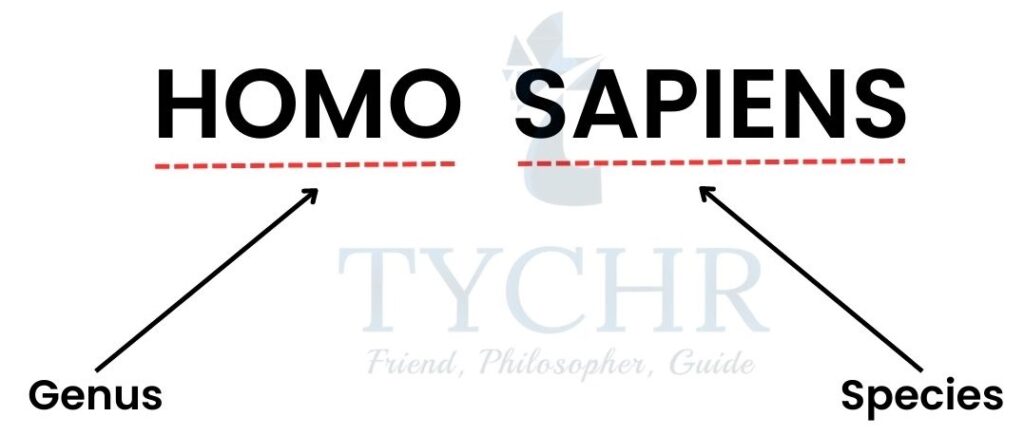
Why binomial nomenclature?- to ensure that every organism has a unique name,
- so that the names can be universally understood,
- to have a stable name by not allowing the people to change the names of the organism without valid reasons.
- The naming of the organisms was popularised by Carolus Linnaeus and now there are certain organisations which fix the name of the newly or pre-existing species.
- International Code of Zoological Nomenclature (ICZN) makes rules for naming and classifying animals.
- International Code of Botanical Nomenclature (ICBN) makes rules for naming and classifying plants.
- International Code of Nomenclature (ICN) for algae and fungi makes rules for naming and classifying fungi and algae.
Taxonomy
- Domains of life
All the organisms that exist or existed (with the exception of viruses because they are considered as non-living) are classified into three domains namely; Archaea domain, Eubacteria domain and Eukaryote domain.- Archaea domain constitutes archaeans which are capable of living in extreme environmental conditions. They can be categorised as thermophiles (heat-loving), halophiles (salt-loving), methanophiles (methane-loving).
- Eubacteria domain consists of all the prokaryotic bacteria.
- Eukaryote domain consists of all the rest of the existence from microscopic yeast to the largest living creatures.
- The objective of classification is to represent how organisms living or extinct are linked.
- Principle Taxa
Further classification occurs by classification of the organism into seven different taxa.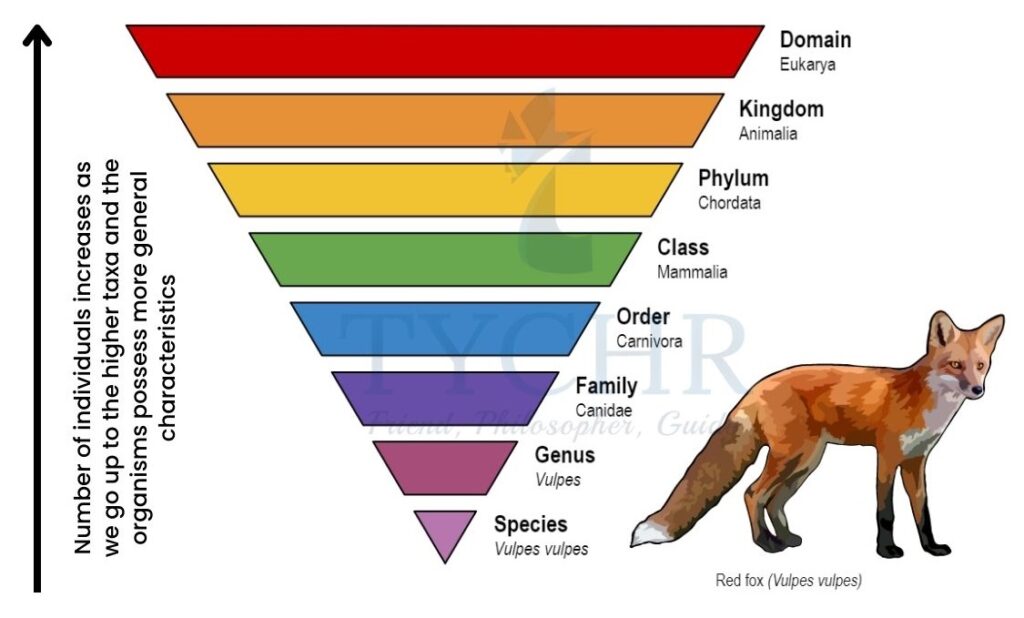
- In the early 18th century, the organisms were classified by observable characters only but by time advancement in technology offers a more complex basis of classification by observing DNA sequences.
- R.H. Whittaker in 1969 proposed a five Kingdom classification based on cell structure, thallus organisation, modes of nutrition, reproduction and phylogenetic relationship.
Plant phyla: Examples
- Bryophyta – Short stature, non-vascular plants are categorised under this phylum. Ex- liverworts.
- Filicinophyta – It is also called pteridophyta, includes ferns and horsetails. They have a well developed vascular system, recognised by the absence of flowers and smaller thin leaves.
- Coniferophyta – The plants under this phylum have woody stems and scaly leaves. Example: cedars, pine trees and junipers etc.
- Angiospermophyta – The plants which possess flowers and fruits with seeds inside them are categorised under this phylum.
Animal phyla: Examples
I. PoriferaThis phylum consists of marine animals, sponges. They do not have mouths or digestive tracts, no nerve, no muscle and organs. Has a simple organisation. |
II. CnidariaIt includes sea anemones, jellyfish and corals etc. Some are sessile and some are free swimming with a sting called nematocyst. |
III. PlatyhelminthesIt includes flatworms which are mostly present in the intestines of the mammals. They have a gut but no heart and lungs. |
IV. AnnelidaIt includes annelids, which are the segmented worms for example leeches and earthworms. They too have a gastric tract. |
V. MolluscaIt includes snails, clams and octopuses. They also have a one-way digestive system with one mouth and an anus to excrete out waste. |
VI. ArthropodaIt includes spiders, crustaceans and insects etc. They have hard exoskeleton (made of chitin), segmented bodies and limbs. |
VII. ChordataThis phylum contains the organisms which have notochord in an early stage which converts into the vertebral column of the adult individual. Some individuals may not develop vertebrate columns but do have notochord in one of their developmental stages. These organisms are called the vertebrates. |
|
The vertebrates
Vertebrates are further classified into classes:
- Fish
- They possess gills in order to breathe and fins in order to swim within an aquatic environment.
- They can live in both saltwater and freshwater
- Examples: Salmon, Tuna, Clown fish etc.
-
- It includes frogs and salamanders. They also possess gills but only at an early stage. Gills are replaced by the lungs in the adult stage.
- Caecilians are the legless group under this class which resembles snakes.Amphibian
- They are ectothermic (cannot control their body temperature)
- Reptiles
- This class includes snakes, lizards, alligators and turtles.
- They produce amniote eggs which are characterised by a membrane around it for protection.
- They are also ectothermic (cold-blooded).
- Birds
-
- All the birds are bipedal and possess wings, which are used for flying purposes or swimming like in penguins.
- They have feathers and lay hardened calcium carbonate layered eggs.
- They have no teeth but have jaws in the form of beaks.
- Mammals
- This class includes foxes, squirrels, dolphins, bats, humans in which females possess mammary glands to feed milk to their offspring.
- They are capable of thermoregulation (warm-blooded).
Cladistics
Clades
- Cladistics is an example of natural classification which classifies taxa together according to the characteristics that have evolved more recently. And a clade is the group of organisms that have evolved from the common ancestor.
- There are two types of traits:
1. Plesiomorphic traits
These are the characteristics that have the same structure and function and which are evolved many years ago in the history, also called primitive traits.
2. Apomorphic traits
These are the characteristics that have the same structure and function but that has evolved more recently. - Cladistics takes into account for apomorphic traits.
- All the living organisms have DNA as the source of the genetic information, which however, provides the evidence of a common ancestor of all the species that exists today.
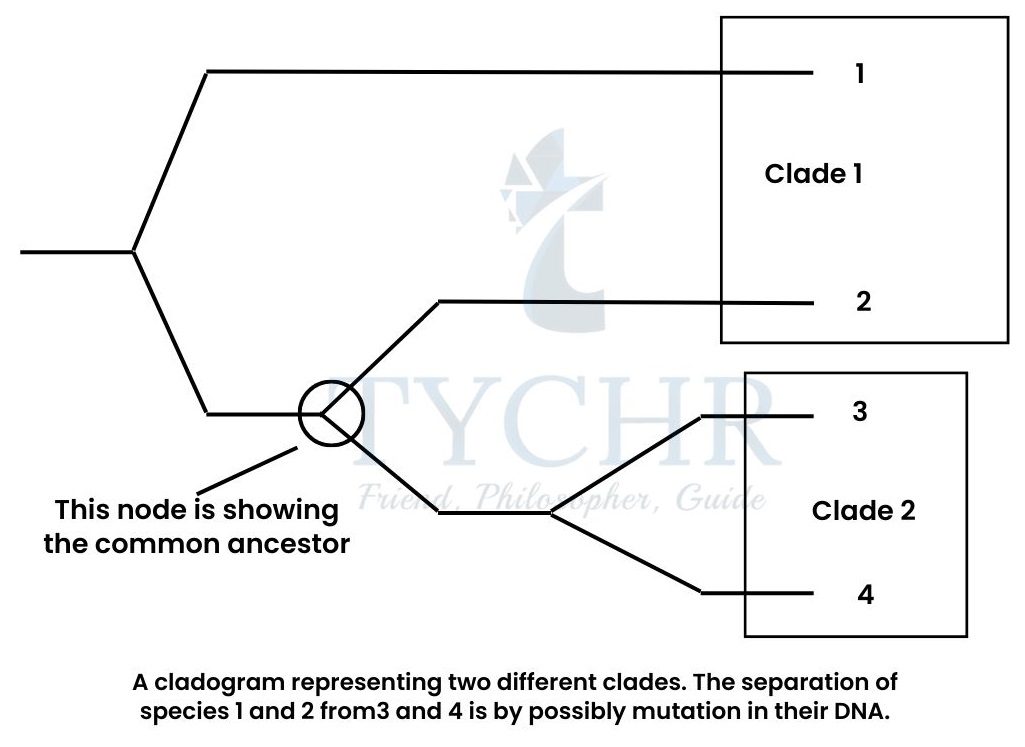
Figure 5.1 A cladogram representing two different clades. The separation of species 1 and 2 from3 and 4 is by possibly mutation in their DNA.
- The biochemical evidence along with any other features are used to make clades of species.
- Mutations in organisms occur at roughly the same rate, so the number of sequence differences can be used to infer how long species have diverged from a common ancestor. This is how it works as an evolutionary or molecular clock.
- Due to homologous and analogous trait (because they lead to opposite ancestors), the morphology is not undertaken while evaluating for a clade but amino acid sequences are trusted.
- The node in cladogram splits the ancestral species into two or more, it creates divergence.
- Cladograms are drawn as an assumption and are not regarded as full proof.
- Since cladistics is based on amino acid sequence, the previously morphologically classified organisms are reclassified on the basis of DNA sequence matching.
- Major changes in classification were observed in the figwort flowers family – Scrophulariaceae. By using cladistics, more than half of the genera shifted to other families including plantain family – Plantaginaceae, Linderniaceae, Orobanchaceae, Calceolariaceae.

